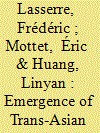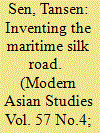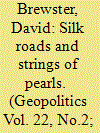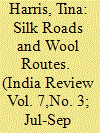|
|
|
Sort Order |
|
|
|
Items / Page
|
|
|
|
|
|
|
| Srl | Item |
| 1 |
ID:
173003


|
|
|
|
|
| Summary/Abstract |
Since 2011, freight transport rail links between China and Europe have been rapidly multiplying. Against all expectations, this commercial initiative, under the aegis of the Deutsche Bahn, has expanded significantly. The number of origin-destination pairs has increased, the number of trains has risen sharply, and both Chinese and European partners have far-reaching ambitions. The railways’ market share of trans-Asian freight is still low. However, rail link development projects have received a spectacular boost from the Belt and Road Initiative (BRI), resulting in the rapid expansion of volume, services offered, and the emergence of new rail infrastructure. Does this development, which needs to be examined more closely, represent a political tool for China? To what extent does the development of these rail links rely on a buoyant market? This article studies the development of rail services and infrastructure by means of a cross-analysis of a body of technical reports and publications by the transport sector’s professional press.
|
|
|
|
|
|
|
|
|
|
|
|
|
|
|
|
| 2 |
ID:
190950


|
|
|
|
|
| Summary/Abstract |
Although inspired by the nineteenth-century term ‘Silk Road(s)’, the phrase ‘Maritime Silk Road’ has its own origins, connotations, and applications. This article examines the emergence of the latter term as a China-centric concept and its various entanglements since the early 1980s, involving the People’s Republic of China’s (PRC) political bodies, academia, the ‘open door’ policy, the pursuit of World Heritage listings, and the current ‘Belt and Road Initiative’. These entanglements, the article contends, have resulted in the emergence of what could be called a ‘Maritime Silk Road’ ecosystem in the PRC. The analysis of this ecosystem presented in the article reveals not only the processes through which a narrative on China’s engagement with the maritime world has been constructed over time, but also its association with issues of national pride, heritage- and tradition-making, foreign-policy objectives, and claims to territorial sovereignty. As such, the ‘Maritime Silk Road’ must be understood as a concept that is intimately entwined with the recent history of the PRC and distinct from its nineteenth-century antecedent, which was used as a label for overland connectivity.
|
|
|
|
|
|
|
|
|
|
|
|
|
|
|
|
| 3 |
ID:
156055


|
|
|
| 4 |
ID:
153517


|
|
|
|
|
| Summary/Abstract |
Control over access to the Indian Ocean is often seen through a highly securitised lens. Strategic actors have long sought to use geographical constraints to maintain the region as a relatively enclosed strategic space. It has only a few narrow maritime entrance points and the littoral is not well connected to the interior of the Eurasian continent. These factors have contributed to the historical domination of the Indian Ocean by a succession of extra-regional maritime powers and the virtual exclusion of Eurasian land powers such as China and Russia. This paper considers how the physical geography of the Indian Ocean has contributed to its control by some powers and the exclusion of others. It then discusses China’s Maritime Silk Route/One Belt One Road initiative, which includes growing interests in Indian Ocean ports and plans to build new overland pathways to connect China with the Indian Ocean. The paper concludes that while China’s growing maritime interests in Indian Ocean are strategically important, it is the new overland routes connecting the Eurasian hinterland with the ocean that have the potential to change the entire geostrategic character of the region.
|
|
|
|
|
|
|
|
|
|
|
|
|
|
|
|
| 5 |
ID:
084549


|
|
|
|
|
|
|
|